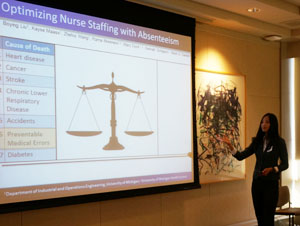Participants: Mark S. Daskin, Mary Duck, Boying Liu, Kayse Lee Maass, Rama Mwenesi, Zhehui Wang, Hannah Schapiro
Project Contact: Kayse Lee Maass, [email protected]; Boying Liu, [email protected]; Mark S. Daskin, [email protected]
Project Synopsis: Increased nurse to patient ratios are associated with both increased costs and improved patient care. Thus, it is critical from both a cost and patient safety perspective that nurses be utilized efficiently and effectively. At the same time, long-term nurse staffing decisions are complicated by the inherent uncertainty in hospital census levels and nurse absenteeism. The latter results from contracted sick days, in-service training periods, holidays and vacation days. To address the staffing problem in the face of these demand and supply uncertainties, we propose a stochastic programming formulation that accounts for variability in the hospital census and nurse absenteeism, day-to-day correlations among the unit census levels, and costs associated with three different classes of nursing personnel: unit, float, and temporary nurses. This enables us to make more informed decisions regarding how many unit nurses to employ, how large a float pool of cross-trained nurses to maintain, how to allocate the pool nurses on a daily basis, and how many temporary nurses to utilize daily. A genetic algorithm is developed to solve the resulting model. Preliminary results using data from a large University hospital suggest that the proposed model can save the hospital hundreds of thousands of dollars annually as opposed to the crude heuristics the hospital currently employs. Since the availability of large numbers of temporary nurses is not assured, the model can be extended to incorporate a chance constraint limiting the probability of needing more than a specified number of temporary nurses.
Papers, Posters, & Presentations:
Papers
- Maass, K.L., Liu, B., Daskin, M.S., Duck, M., Wang, Z., Mwenesi, R., and Schapiro, H. (2015). Incorporating nurse absenteeism into long term staffing with demand uncertainty. (Working paper)
Presentations
- Incorporating Nurse Absenteeism into Long Term Staffing with Demand Uncertainty, INFORMS Healthcare Conference, Nashville, TN, July 2015
- Optimal Long Term Nurse Staffing Considering Absenteeism and Demand Uncertainty, Industrial and Systems Engineering Research Conference, Nashville, TN, June 2015
- Optimal Long Term Nurse Staffing Considering Absenteeism and Demand Uncertainty, Industrial and Systems Engineering Research Conference, May 2015
- Incorporating Nurse Absenteeism into Long Term Staffing with Demand Uncertainty, Poster Presentation, 2015 Dean’s Research Day, University of Michigan, Ann Arbor, MI, March 2015
- Optimal Long Term Nurse Staffing Considering Absenteeism and Demand Uncertainty, Euro Mini Conference Improving Health Care: New Challenges, New Approaches, March 2015
- Nurse Staffing: Models and Analysis, University of Florida, October, 2014
- Nurse Staffing: Models and Analysis, North Carolina State University, October, 2014
- Long Term Nurse Staffing Under Demand Uncertainty, Industrial and Systems Engineering Research Conference, June 2014
- Nurse Staffing: Models and Analysis, University of Buffalo, February, 2014
- Nurse Staffing: Models and Analysis, Penn State University, October, 2013
Posters
- Optimizing Nurse Staffing with Absenteeism, Healthcare Engineering & Patient Safety Symposium, September 2014
- Long Term Nurse Staffing Under Demand Uncertainty Using Unit, Float, and Temporary Nurses, Healthcare Engineernig & Patient Safety Symposium, November 2013
Acknowledgements: We gratefully thank Ms. Mary Duck and Rama Mwenesi who have been patiently explaining nurse staffing mechanics of UM hospital to us and gathering data for our project.

